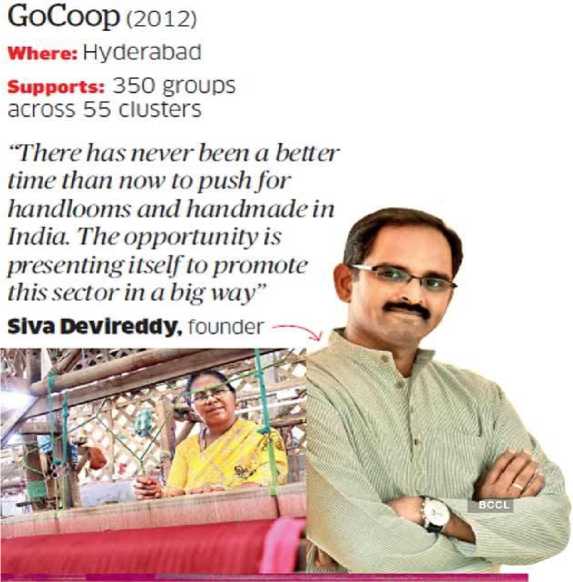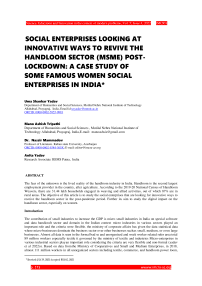Social enterprises looking at innovative ways to revive the handloom sector (MSME) post-lockdown: A case study of some famous women social enterprises in India
Автор: Uma Shankar Yadav, Mano Ashish Tripathi, Nasir Mammadov, Anita Yadav
Журнал: Science, Education and Innovations in the Context of Modern Problems @imcra
Статья в выпуске: 4 vol.5, 2022 года.
Бесплатный доступ
The fear of the unknown is the lived reality of the handloom industry in India. Handloom is the second largest employment provider in the country, after agriculture. According to the 2019-20 National Census of Handloom Weavers, there are 31.44 lakh households engaged in weaving and allied activities, out of which 87% are in rural areas. The objective of this article is to study the social enterprises that are looking for innovative ways to receive the handloom sector in the post-pandemic period. Further its aim to study the digital impact on the handloom sector, especially on women.
Короткий адрес: https://sciup.org/16010224
IDR: 16010224 | DOI: 10.56334/sei/5.4.13
Текст научной статьи Social enterprises looking at innovative ways to revive the handloom sector (MSME) post-lockdown: A case study of some famous women social enterprises in India
The contribution of small industries to increase the GDP is micro small industries in India on special software and data handicraft sector and domain in the Indian context micro industries in various sectors played an important role and the criteria were flexible. the ministry of corporate affairs has given the data statistical data where micro-businesses dominate the business sector over other businesses suchas small, medium, or even large businesses. Almost all data is seen in the formal bad se and unorganized and week worker related ruler area total 89 million workers especially textile it governed by the ministry of textile and industries Micro-enterprises in various industrial sectors playan important role considering the criteria are very flexible and non-formal (yadav et al 2022o). Based on data from the Ministry of Cooperatives and Small and Medium Enterprises, in 2018, almost 111 million workers in all unorganized sectors including textile, commerce, and handloom power loom, in micro small and medium enterprises it is especially governed by the ministry of MSME but the digital dived is larger in that sector. in major of the worker a far apart from the digital connectivity. It information and communication technology and branding like as 4 g and 5 g technology in India in the final time as it is already the l governed by the according to Yadav us the whole of the system is not covered by the handicraft sector and small industry worker make the product using Juki machine and easy all handicraft section. al handicraft sector workers it should be unorganized by mostly ant the system (yadav et al 2022p)
This secondary data consists of primary legal materials, secondary legal materials, and tertiary legal materials as follows:
-
1. p rimary l egal m aterials , namely, legal materials whose contents have binding power to the community originating from agreements and laws. Primary legal materials used in this research are:
-
a. l aw n umber 25 of 2007 concerning i nvestment ;
-
b. l aw n umber 20 of 2008 concerning m icro , s mall , and m edium e nterprises ;
Government Regulation Number 23 of 2020 concerning Implementation of the National Economic Recovery Program in Support of State Financial Policy for Handling the Corona Pandemic and/or Facing Threats That Endanger the National Economy and/or Financial Stability and Save the National Economy (Harbullah et al 2014)
Some famous Social enterprises looking for innovative ways to revive the handloom sector and women’s engagement
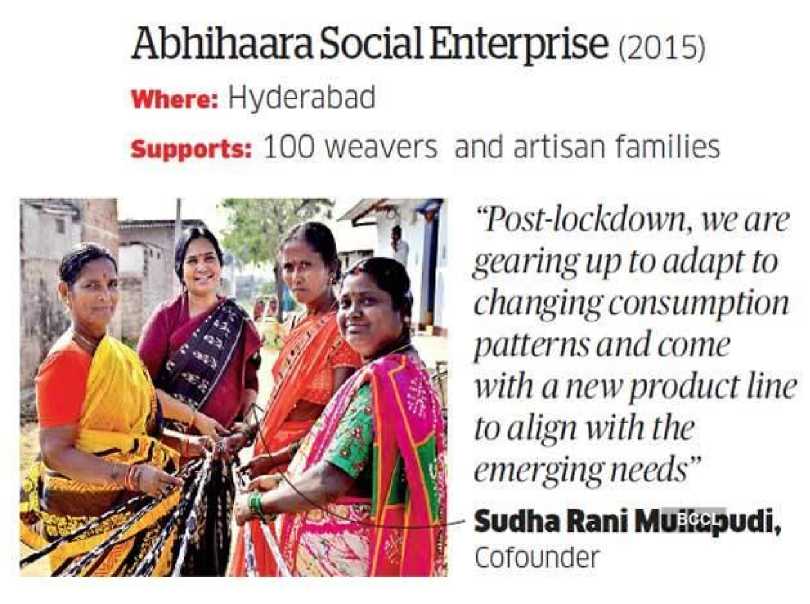
Abhihaara Social Enterprise (2015)
where: Hyderabad supports: 100 weavers and artisan families patterns and come with a new product line
"Post-lockdown, nr are gearing up to adapt to emerging needs'
Sudha Rani Muitapudi, Cofounder
Figure 1.
Abhidhara social enterprises of women NGO working with 100 women
Definition of MSME Micro, Small, and Medium Enterprises
Micro units
MSMEs will now be called Micro units if they have investments up to Rs 1 crore and a turnover of less than Rs 5 crore. The definition earlier was on investment criteria of up to Rs 10 lakh for Service MSMEs and Rs 25 lakh for manufacturing Murtahin (1995); Nayak (1994).
Small units
For an MSME to be defined as a Small unit, its investment limit has been raised from Rs 5 crore to Rs 10 crore with a turnover of fewer than 50 crores GDT his applies to all MSMEs.
Medium units
Enterprises with investments up to Rs 20 crore with a turnover of less than Rs 100 crore will now be called Medium units. Earlier, the investment limit for Medium units was up to Rs 10 crore and for Service enterprises up to Rs 5 crore (Yadav et al 2022a)
Existing and Revised Definition of MSMEs
|
Existing MSME Classification |
|||||
|
Criteria : Investment in Plant & Machinery or Equipment |
|||||
|
Classification |
Micro |
Small |
Medium |
||
|
МГц. Enterprises |
In vest ment |
In vestment*Rs. 5 cr. |
Investment |
||
|
Services Enterprise |
InvestmentRs. 10 lac |
Investment* Rs. 2 cr. |
InvestmentRs. 5 cr. |
||
|
Revised MSMEClassification |
|||||
|
Composite Criteria : Investment .And Annual Turnover |
|||||
|
Classification |
Micro |
Small |
Medium |
||
|
Manufacturing & Services |
Investment Rs. 1 cr. and Turnover* Rs.5 cr. |
Investment* Rs. 10 cr. and Turnover* Rs.50cr. |
Investment* Rs. 20cr. and Turnover* Rs.lOOcr. |
||
-
FIGURE 1 MICRO SMALL AND MEDIUM ENTERPRISES
Source :Ministry of MSME.
Figure 2: Micro Small and Medium Enterprises.
Source: Ministry of MSME.
Role of SME
In the global economy, micro, small and medium-sized enterprises play a crucial role, and they are considered the engine of growth in most countries. MSMEs ensure a more equal distribution of national income, fuel balanced regional industrial growth, serve as a nursery for entrepreneurship, and promote the mobilization of local capital and otherwise unused skills (Yadav et al 2021a).
They also play a key role in developing the economy with their strong, profitable, scalable, and innovative entrepreneurial spirit. Today, the small-scale industry is called Micro, Small, and Medium Enterprises, based on their investment. Compared to medium and large-scale industries, small industries are small in operational employment, products, energy, technology, etc (Yadav et al 2021b).
The micro, small, and medium-sized sectors have emerged in recent years as a dynamic and vibrant sector of the Indian economy, with exceptional growth in the production, employment, and distributed growth sectors in general and in exports in particular(Yadav et al 2022c). Consequently, the Government of India has encouraged and supported the promotion of small-scale industries through explicit policies such as protection against large-scale industry, capital subsidies, differential tax treatment, reservation, etc (Yadav et al 2022d).
Four months ago, at the remote Gajendragarh village in north Karnataka, textile revivalist Hemalatha Jain was preparing weavers at her Punarjeevana Trust for the tough times ahead. At that point, they found it hard to believe that something terrible was looming over them. But soon the looms fell silent, the stock stood still, and the cash stopped flowing. As they swung from disbelief to a crushing fear of the unknown, Jain had to allay the panic in the community (Yadav et al 2022e). The immediate requirement was to get some cash in their hands,” she recalls. They fashioned masks and Jain pulled in some favours to start sales with deferred deliveries. The fear of the unknown is the lived reality of the handloom industry in India. Handloom is the second largest employment provider in the country, after agriculture. According to the 2019-20 National Census of Handloom Weavers, there are 31.44 lakh households engaged in weaving and allied activities, out of which 87% are in rural areas. Over 70% of all weavers and allied workers are women. Jaya Jaitly, president, of Dastkari Haat Samiti (DHS), says there is no accurate figure for the number of people (Yadav et al 2022f).
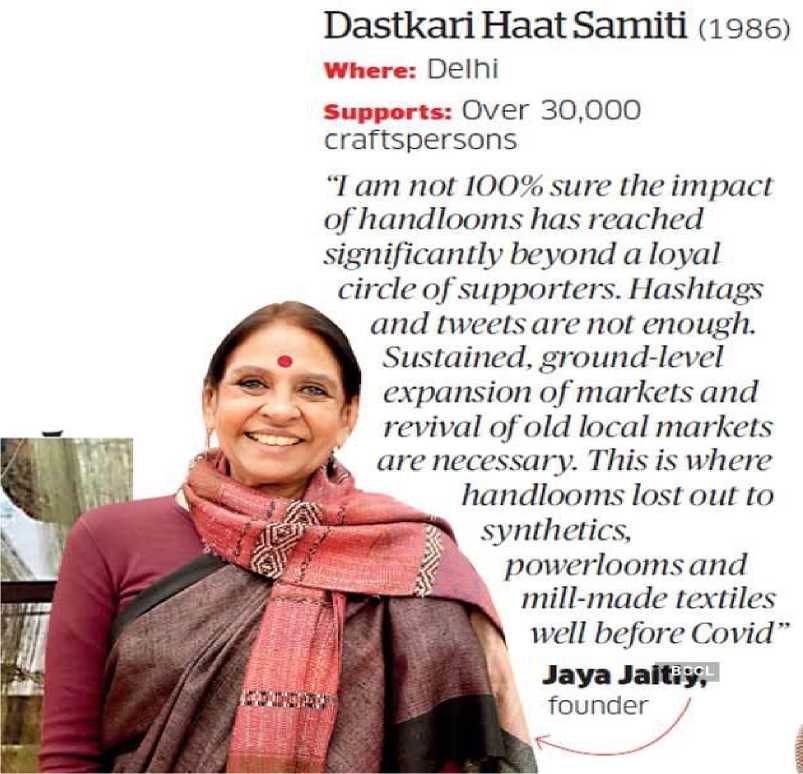
^^Lx
Dastkari Haat Samiti (1986)
Where: Delhi
Supports: Over 30,000 craftspersons
‘7 am not lOO%sure the impact of handlooms has reached significantly beyond a loyal and tweets are not enough. Sustained, gro i ind-level expansion of markets and revival of old local markets are necessary. This is where handlooms lost out to synthetics, powerlooms and "—mill-made textiles i vcl I before Co i id ”
Figure 3 showing NGO related to handloom Dastkaari Haat Samity by Jaya Jaitly
Recently, the Textiles Ministry abolished the All India Handicrafts Board and the All India Handloom Board. Jaitly says dismantling the practically non-functional board is a good step. “Maybe a more purposeful, knowledgeable, and experienced advisory body of independent persons could assist the government (Yadav et al 2022g). But it is high time private bodies of all sizes and strength formed a major representative federation like FICCI or CII to articulate and push for the needs of the textile and craft sector.”
While a central board is gone, smaller craft collectives, social enterprises, and organizations are becoming key drivers of change at a time when weavers and craftsperson’s are left with little or no work. The DHS, for instance, got to work from Day 1, checking on its member base and providing rations, funds, and more. Jaitly says, “We ensure they are helping each other too. Multiple groups and people got together during Covid to connect with the entire sector to provide relief (Yadav et al 2022h).”
“Covid has actually brought the handloom sector together. There's a lot of sisterhood. Tot instance, Okhai transformed from a product company to a marketplace with 35 non-Okhai collectives and many other artisans retailing through us. July revenue is 157% higher than last year's"
Kirtl Poonia, head -^

Figure 4. Carrying handloom near to sisterhoods
If Meera Goradia of CreativeDignity.org — a group of diverse creative professionals like Ayush Kasliwal, Pooja Ratnakar, and Vishpala Hundekari — is to be believed, many in the handloom sector are on a WhatsApp group, brainstorming on ways to help each other. At the start of the lockdown, funds were set up by organizations like Dastkar, the Fashion Design Council of India, and designers like Anita Dongre. On July 31, CreativeDignity launched its Artisans Direct campaign with a crafts-based online mark(Yadav et al 2022i)
Sudha Rani Mullapudi, the cofounder of Hyderabad-based Abhihaara Social Enterprise, says liquidating the stock that is lying with them— worth about Rs 45 lakh — is their immediate concern. Post-lockdown, Abhihaara is adapting to changing consumption patterns and coming up with new product lines. “As work from home is the new norm, we are focusing on the production of home products like towels, masks, cushions, bed and table linen. We are investing in building easy-to-learn skills that would generate income (Yadav et al 2022j)
Many enterprises are similarly rethinking products and processes. Swati Seth of The Color Caravan, a Himachal Pradesh-based social enterprise known for crochet toys and nursery items, plans to experiment with natural dyes, natural fibers, and materials, and dabble in local crafts like Khadi weaving and bamboo basket weaving. “We were already operating online through our Instagram and Facebook page. But early on in the lockdown, I opened an Instamojo ‘store’ and we plan to launch our independent organization (Yadav et al 2022k)
Digital literacy and presence have become a prerequisite for Craftspersons now. Goradia says they are trying to drive the digital transformation of artisans by involving design schools like NIFT, Srishti, and IICD to guide them in shooting product pictures, creating digital catalogues, and managing sales, as online marketplaces are the way forward. Kirti Poonia, head of Okhai, says the lockdown period has transformed them from a product company to a marketplace with 35 non-Okhai collectives (Yadav et al 2022l).
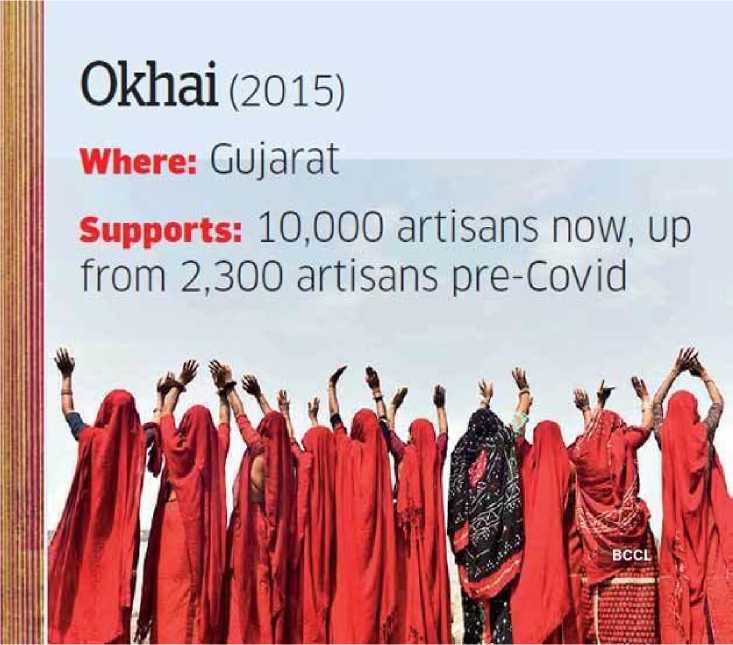
Figure 5. NGO of women handloom
Hyderabad-based GoCoop launched a KindnessInKind campaign a few days into the lockdown, inviting customers to post photos of their favorite artisanal products. Siva Devireddy, the founder, says the key is to help weavers sell products directly.
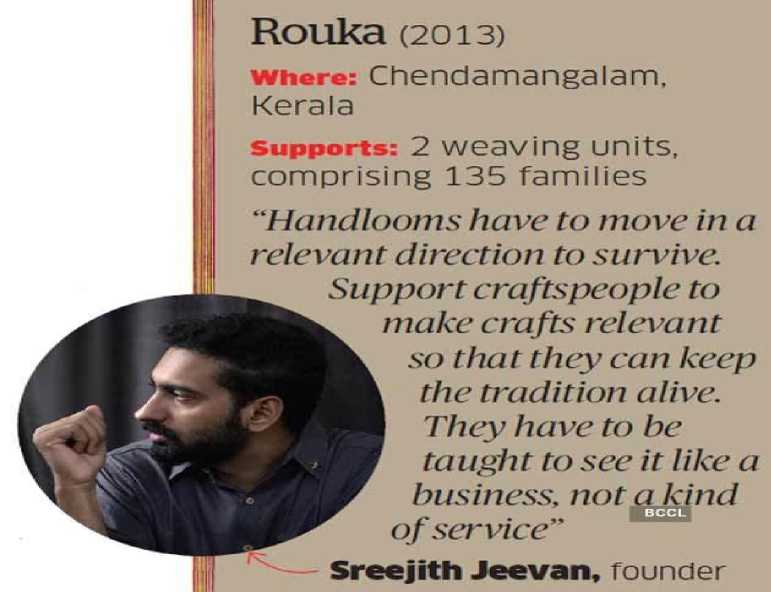
so that they can keep the tradition alive.
, V taught to see it like a business, not a kind ~ of service”
Sreejith Jee van, founder supports: 2 weaving units, comprising 135 families
“Handlooms have te) move in ei relevant direction to survive.
Support craftspeople te)
Rouka (2013)
where: Chendamangalam, Kerala
Figure 6. Rouka NGO showing kind supporter of country
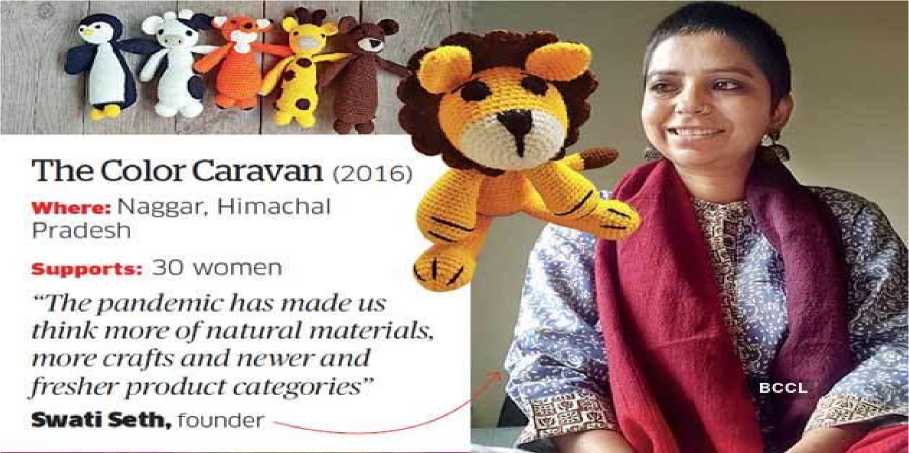
Figure 7 showing Female NGO of handloom in Gujrat
Kochi-based designer Sreejith Jeevan of Rouka thinks otherwise. He says, “Any product needs to find meaning to exist. For example, everyone has a plain Kerala kasavu sari How many of those will people buy till you give them another version? Supporting craft because the craftspeople are protecting tradition is not a valid story. Support craftspeople to make crafts relevant so that they can keep the tradition alive. They have to be taught to see it like a business, not a kind of service.”
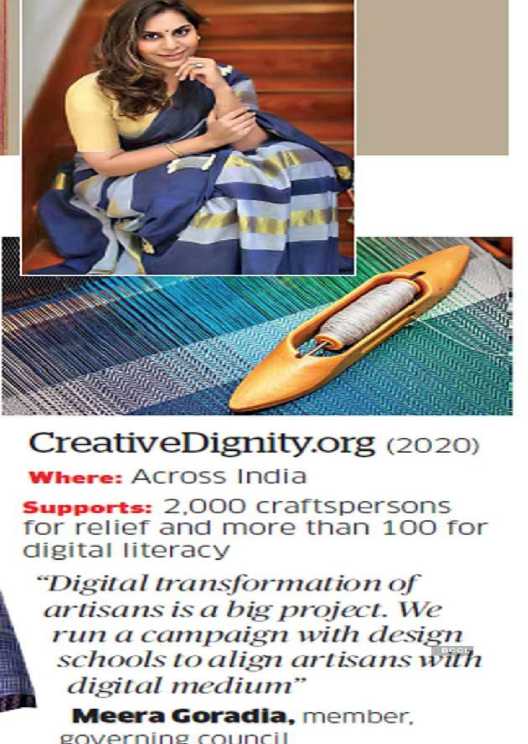
run a campaign with design schools to align art isa ns with digital medium"
Meera Goradia, member.
eovprnina council
where: Ac Poss India
Supports.: 2.000 craftspersons Tor relief and more than 100 for digital literacy
Figure 8. Creative dignity foundation of handloom NGO
The smaller enterprises are also showcasing stories over social media. Mullapudi says that it’s a great interface, giving more value to weavers and artisans: “Strong campaigns should be built to have 10% of the wardrobes of every citizen (those who can afford it) filled with handlooms.”
For the sector to grow, handlooms should become an everyday product and not a special buy. Hashtags might make them hip but to truly lend a helping hand, everyone from the government and entrepreneurs to weavers and consumers must come together.
India had been the LAND attracting ALL NATIONS across the GLOBE a few Centuries ago and it appears to be that the WHEEL has turned again for INDIA to be the CENTER of ALL TRADE Business and such Innovative ways to revive the HANDLOOM by these Social Enterprises is AMAZING and WOULD sooner Revolutionize the way INDIA would be looked GoCoop 12012) where: Hyderabad Supports: 350 groups across 55 clusters “There has never been a belter time than now to push for handlooms and handmade in India. The opportunity is presenting itself io promote л this sector in a big way" Siva Devireddy, founder - 5 Figure 9. Showing GOCOP cluster related to NGO of handloom. The objective of the study • To study the social enterprises and innovative ideas to revive the handloom in India after pandemic • To suggest the comparative study of the strategies and approaches for developing a one district one product like one district one product and developing a global handicraft index Review of the literature Even in the case of one station one product, there are nothing sources available in any literature review but if we see that in case of one district one product and other handicraft product then some of the literature reviews are present so they can help to understand the strategies and further study about the one station one product. And specifically, the handicraft sector yada et al has studied board in case of tartare development, entreprmriual development, gig economy and strategies, terracotta, and handicraft. so we study one by one in the literature review. Khadi and Handloom, Handicraft, Village Industries, Bamboo Based Industries, Sericulture, and Lock, etc. are traditional small-scale industries GoI. (2006). A wide range of products ranging from relatively simple items to sophisticated products such as television sets, electronic control systems, mixer grinders, and various engineering products are produced by modern small-scale industries, particularly as ancillary to large industries Group (1981). Traditional small businesses are highly labor-intensive, whereas modern small-scale units use highly advanced machinery and equipment Hasnain (2007). The following literature supports the current study, like the study done by Yadav U.S et al 2020 described the important steps that are useful for the development of this sector of the country they explained the import of handmade carpet and shazar stores. (Vanita ahlavat 2018) Her paper focused on labor productivity and countries’ textile sector” she has discussed in her paper that most of the labor is women in the textile industry. A study conducted by Roy, Patnaik, and Satpathy (2020) for 690 handicraft industries (Small business) enterprises found a drastic fall in the growth rate (this was due to pandemic covid -19 of net sales by (-) 66.7% in the first quarter of the financial year 2020–21. Yadav U.S et al 2022 discussed a visionary concept of the global handicraft index and role of the role of handicraft artisan and strategies for the development of the. The situation worsened further when the government announced the extended nationwide lockdown amidst the COVID-19 crisis. Ananda, Abhishek, et. al (2020) and (Yadav et al 2022). Impact of COVID-19 pandemic on Micro, Small, and Medium Enterprises (MSMEs)." Results suggested that there is enormous gender disparity in employment; that is women are very few in comparison to men workers. published their research paper "Study of Handicraft Marketing Strategies of Artisans in Uttar Pradesh and Its Implications" as we have discussed the performance of the handicraft sector and the role of women in the handicraft sector or home-based industry. But (Yadav et al 2022) published about the performance of women in ODOP of Uttar Pradesh and they gave an initial approach to the developing global handicraft index for small businesses. A new concept for the development of the handicraft industry in the world and to enhance the positive completion in a new era there is a need for a global handicraft index (Yadav et al 2022b) and (Yadav et al 2021a). we know that women are involved in the handicrafts sector and their performance is increasing day by day even during the pandemic time. So it needs to make strategies for its development in the handicraft industry Yadav et al 2022a). in the case of formal and informal knowledge transformation in the handmade carpet industry, Yadav et al analyzed the good criteria for the transformation of institutions, (Yadav et al 2022). How to develop business strategies for upgrading the handicraft artisan’s skills there is a need for special strategies (Yadav et al 2021b). (Yadav Nassir Mammadove et al 2022d) described important small industries in Azerbaijan and different handicraft industries and how to develop special strategies in the sector. some famous handicrafts industries in Uttar Pradesh are also in the decline phase and we need to improve this shazar stone sector (Yadav et al 2022). Same year Yadav and Nassir mommadov studied one station and one product in India and suggested some technical strategies for the development of handicraft products. Research methodology The nature of the analysis was based on the descriptive study. The primary data are collected through the structured questionnaire by interview schedule method. Secondary data was collected through books journals and other Publications. The respondent of the precise study is the private sector, micro, and household handicraft workers inUttar Pradesh. The Sample size of the study is 268 by Krejcie - Morgan rule and the sample populationis covered in districts of Uttar Pradesh like Banda, Moradabad, khurja, Prayagraj, and the famous Magh Mela of Uttar Pradesh. Stratified and simple random sampling isused in the present study. Anova and Correlation are the statistical tests used in the study for testing the hypothesis further a qualitative method has been used to examine the role of Government in the one district one product (ODOP) scheme, for this study paper author(s) interviewed different artisan and analyzed various reports such as UP Government and journals stratified Random sampling method has been adopted for sample areas Bhadohi and Banda of Uttar Pradesh. The sample size was 268. For this mostly primary data was taken for papers while secondary data was only for literature review and taken from different papers and magazines. Secondary data has been selected from the various which are from NSSO and NITI Aayog report 2019 and Ph.D. Chamber of Uttar Pradesh, some NGOs report Jila Udyog Sangh of Banda and Bhadohi from Uttar Pradesh for data analysis. Data analysis Sampling was selection acted as a stratified random sampling method and data has been analyzed using appropriate tools and software, especially SPSS software. Table 2: Age of the respondent’s RESPONSE FREQUENCY PERCENTAGE Below 30 Years 45 16.7 30-40 Years 60 22.3 40-60 Years 155 57.8 60 Years Above 8 2.9 Total 268 100 (Source: Primary data and computed by authors) The table describes that 16.7% of respondents belong to 30 years, 22.3 % of respondents belong to 30 to 40 years, 57.3 %of respondents belong to40 to 60 years 2.9 % of respondents belong to 60 years, and above. Table 3: Gender of the respondents RESPONSE FREQUENCY PERCENTAGE Male 186 69.4 Female 82 30.5 Others 0 0 Total 268 100 (Source: Primary data and computed by authors) The Table that 69.4% of respondents are male and 30.5% of respondents are female. It infers thain is female participation is lower than male. Findings discussion and strategies Social enterprises have given more opportunity and flexibility to the women in the handloom sector and handicraft sector by sailing and marketing products in India in this digital era. One station and one product have been given a new opportunity to the artisan near the station and given fame o to local artisan at the global level., The majority of the worker’s neutral level of satisfaction in working in the handicraft sector they are primarily educated; no other job skill or age does not permit another that’s why they are working in the handicraft sector. The majority of the workers are not satisfied with the wages (27.6) they earn from the handicraft work. there should be a Global bamboo craft park, a global stone craft park, a global leatherpark, etc. these will attract artisans and entrepreneurs to develop sustainable products. Ihope this strategy will help the national government and global government to improve the quality, skill, production, export, emplacement, GDP, patent, infrastructure development traditional conservation of art and craft, turning towards a sustainable world, and promotion of local talent. The ministry of minority affairs launched a skill training program to enhance theskill level in minorities community, to index the countries that which country have the maximum number of women entrepreneurs in the handicraft sector and the case of India to indexing state which state has the maximum number of women entrepreneurs in handmade craft production also which contrite s handicraft women entrepreneurs are much happy, as well as green job provider the same condition should be in India case namely, strive scheme Atmanirbhar Bharat scheme, SARAS scheme, Gunnar haat (Aswani et al 2020). Result: From the discussion, it has been clear that a newly launched scheme of one station one product will give a new and strong marketing ideology to the researcher and it increases the skill motivation, marketing, promotion, export of handmade products, receiving the traditional handicraft in our new genera and on the artisan. This is helpful for income generation GDP increment, skill enhancement, and entrepreneurial development. is key to creating sustainable products and products are decorative, utility traditional, and heritage-based (Jaya Prakash Pradhan, 2011) so there should be the highest demand for this product, and government should care about the welfare of the artisan and handicraftproduct conservation for generation welfare and try to enter the skill of the artisan and revive the craft skill live in front of the machine-made. When the time is Covid 19 whole worlds are facing then this proposal of handicraft index will motivate and promote the production, skill in handicraft and much more opportunity of the artisan in the sector in last generating GDP and income. every country and all related NGO SHG should try to develop this type of index at the global level and It has been clear from the above discussion that global handicraft in the proposal can solve their job problem by initiation g the handicraft sector and it also gives the better completion, promotion skill enhancement of artisan institution la awareness and any of the best facility to craft technology and will attractant the corporate owner and worker toured its local craft increasing the skill and increasing the GDP of the country can solve the problemof income generation migration, provide employment in India and decrease the impact of Coved 19, and boost the Indian economy (Yadav et al 2022k). These training programs need to be planned according to the market requirement so that they can make use of training immediately. Indianeconomy will get a boost when more workers from this sector will be involved in this sector and income will be generated to increase the GDP of the country as well as at the global level(Yadav et al 2020). CONCLUSION: The pandemic situation has created more problems for people Even in this tough time for the whole world and millions of the population has lost their life due to Covid 19. In this situation, the government thought that there is a need of boosting the Indian economy by promoting local crafts and traditional crafts in this chain ministry of the railway stated the One station product scheme, and also it was declared in the union budget 2022-23. Artisans and workers returned to their homes and then engaged in hand-making products that they were adopted from their ancestors. returned to their country, state from own state economy slowdown of the whole world but in this situation, in this situation handicraft sector has potential to provide job and to create and upgrade their skill and start-up at the local level to provide more job to solve the problem. (Yadav et al 2022).